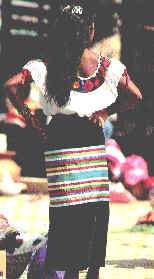|
|
Many ethnic groups live in Chiapas, who still keep their traditions, languages and folklore alive. Their economy is based on cultivation, corn, beans, squash, potatoes, vegetable pears, tomatoes and other plants, and also raising animals, such as pigs and poultry. In addition, many natives in Soconusco region work on coffee plantations.
Their ethnic groups now living in the region are Tzotzils and Tzeltals in the center of the state, area known as Chiapas Highlands, Chujes, Choles and Zoques in North, Tojolabalas in Southeast, Mames, Cakchiquels and Mochos in South of the state and also part of Guatemala and Lacandons, who live in Eastern rain forest.
All these tribes speak languages derived from Maya, except for Zoques, whose language is related to that of Mixes in Oaxaca State and of Popolucas of Veracruz. The largest of these groups is that of Tzeltals, which ranks eighth in size among Mexico's indigenous people.
Broadly speaking, natives of Chiapas hold various beliefs that are repeated from group to group. For example, the idea that every human being has spiritual animal double in common to almost all of them. This animal, which shares person's destiny, may be eagle, margay or showy bird. Until a few years ago, Choles used the name of a plant or animal as their second surname.
Ancestor worship is practiced and legends are perpetuated about super natural beings, demons and animal doubles that live in rivers, forests and mountains. Choles, for example, take care of certain sacred caves, as they believe that they are homes of spirits, which control rain, wind, storms and other natural phenomena. Lacandons still practice rite in honor of the old man Nojoch-yum-chac, god of rain.
Another characteristic is the religious syncretism of ancient beliefs and Catholicism. Tzeltals venerate "talking crosses", sculptures associated with pre-Hispanic idols, which according to tradition talk to the the faithful.
Of all the fiestas organized by different groups of the state, Chamula Carnival, also called Kin Tajimultic, is the most famous. This is the most important fiesta of Totzils and includes cavalcades, ritual dances, procession of flags and the spectacular fire running. These ceremonial activities serve to reaffirm the group's identity and to revive ancestral religion based largely on agriculture.
Other groups show syncretism in their beliefs: Choles worship Black Christ in the town of Tila; Tojolabals organize pilgrimages to visit different saints, but at the same time venerate sun, which they regard as creator and protector deity, as well as moon, the steered of life.
Lancadons still hold to their ancient beliefs and put them into practice regularly. For example, head of family line feeds the gods with pozol, a drink made of corn. This rite is accompanied by chant reasserting the group's respect for its environment, its own history and continuity of life.
Natives of Chiapas practice both sorcery and traditional medicine, along with their magic and religious activities. They have their own Ilol, who is the folk healer with wide knowledge that he uses to heal both bodies and souls. These special people believe that sickness is caused by imbalance between man and his social or supernatural environment.
Ethnic communities of Chiapas have various system of social and administrative power. There are Stewards (Mayordomos), who are the decision-making leaders of groups. Choles have traditional form of government under the care of elders, while Lacandons recognize the oldest member of Caribal (traditional cluster of huts) as their sole authority. Among Zoques, for example, there are Albaceas, who take care of images, and Fiscales, who are in charge of rites, chants and prayers.
Colorful costumes of ethnic groups in Chiapas are as varied as the countryside that surrounds them. Large number of their mythological figures are woven into their clothes.
Tzotzil women wear shifts (Huipiles), incorporating sun symbols, geometric butterflies, flowers, cornfields and toads. The brightly embroidered shifts of Tenejapa in Tzeltal stand out against the green backdrop of vegetation.
Climate of each region also influences dress. Lacantons, living in heat and humidity of the rain forest, wear long white tunics, while Tzeltals in mountains have to protect themselve from cold, with thick woolen jackets. Chujes wear Capisayos, capes made of palm leaves, which are very useful against rainy climate of the region where they live.
Among some groups, such as Tzotzils, costume is not simply clothing, it is a mark distinguishing group from group. Change of costume signifies change of personality, culture and home.
Chiapas is also famous for its crafts. Tojolabals make various articles in wood and clay. Lacandons produce reed flutes, hammocks, nets, leather bags, polished and decorated grounds, clay dolls and necklaces of seeds. Zoques are masters at baskets and making toys. All groups in general are excellent weavers.
Dances are always feature of native festivities. Choles perform dramatic ones, symbolizing fight between bulls and jaguars, or between them and Spanish. In Holy Week, instead of dancing, they go on pilgrimages, headed by Tatuches or elders.
Zoques have different dances; "Women's Dance" (Yomo etze), Corn Dance (Mote' Xu), and the dance of Malinche or Malintzin, because this woman who helped Cortes in the Conquest, wasoriginally from Copainanla.

|
|

